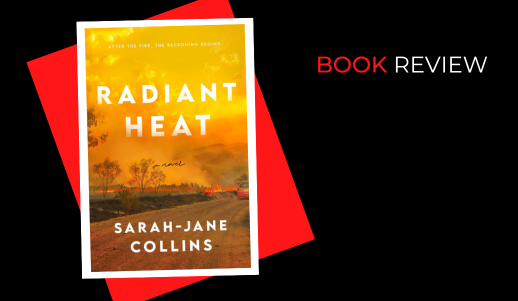by Sarah-Jane Collins
Publisher: Berkley, an imprint of Penguin Random House Australia, 2024
Publisher’s blurb
When a catastrophic wildfire suddenly rips through a woman’s hometown, she thinks she is lucky to have survived… until she finds a dead woman in her driveway, clutching a piece of paper with her name on it.
The blaze came out of nowhere one summer afternoon, a wall of fire fed by blustering wind. Yet, somehow, Alison is alive. She rode out the fire on the damp tiles of her bathroom, her entire body swaddled in a wet woollen blanket. As flames crackled around her, the bitter char of eucalyptus settled in the back of her throat, each breath more desperate than the last.
The wildfire that devastated the Victoria countryside Alison calls home sets in motion a chain of events that threatens to obliterate the carefully constructed life she is living. When Alison emerges from her sheltering place, she spots a soot-covered cherry red car in her driveway, and in it, a dead woman. Alison has never met Simone Arnold in her life . . . or so she thinks. So what is she doing here?
As Alison searches for answers across Australia’s scorched bushlands, she soon learns that the fire isn’t the only threat she’s facing.
Review
by Kay Weller
I generally know if I am going to enjoy a book if I feel the need to peak at the ending after reading the first few chapters. With Radiant Heat, by Sara-Jane Collins, I was tempted after the first few pages! But with this book, you can only appreciate the subtlety of the ending, and how it draws together the various strands of the story by travelling the difficult, raw and demanding path with the main character, Alison.
The book is set in Lake Bend, a country town inland from Melbourne where Alison grew up. She has just returned from Cairns in North Queensland after the recent deaths of her parents in a car accident.
Radiant Heat opens in the visceral aftermath of a bushfire, which Alison survives by taking refuge in her bathtub, covered by a wet blanket. When she emerges, she finds the body of a stranger in her driveway, a young woman, trapped in her car by falling timber. The woman, identified later as Simone, has Alison’s address with her.
Alison escapes through a hellscape of charred bush to Lake Bend, where she stays with Sal, who has been a constant in her life, providing motherly warmth and no-nonsense advice along with copious cups of tea. After reporting the body to the police, she reconnects with Billy, a childhood friend who is now a policeman. Solid and strong, Billy offers her the promise of safety and continuity. Throughout the book there is the tension of “will she, won’t she”, and worrying about their potential relationship was one of the reasons I wanted to peek at the ending!
As the police and Alison investigate the mystery of what brought Simone to Lake Bend, a sinister link emerges between the two women. They both lived in Cairns and shared the same ex-partner, Gil. Through hints and a skilful use of flashbacks, we start to learn the disturbing truth about Gil and the effect he has had on Alison. She had thought he was finally out of her life, but the danger is much closer to home than she thinks.
Alison is a complex character, scarred and traumatised by the consuming nature of her ex-lover, a difficult relationship with her parents, and the rampant destruction of her familiar world by fire. She is a painter, and we experience the world through an artist’s eyes and with an artist’s feelings. The prose is full of evocative imagery and summons all the senses to immerse us in her world.
When an ancient tree falls: timber splits and splinters with a wrenching that slices through time and tears at the tranquillity of the day. And in the ocean, she sees a school of flathead dancing, suspended in the crystal liquid.
Throughout the book, the fire is used as a metaphor for Alison’s life: it’s an all-consuming, devouring power, evocative of the insidious, suffocating effects of coercive control. Ultimately, she is trying to resurrect herself, like the bush around her which has been obliterated by forces beyond her control.
I loved Radiant Heat and will read it again. The language is beautiful, the themes are topical and relevant, and the ending is a subtle, thoughtful triumph. Highly recommended.
